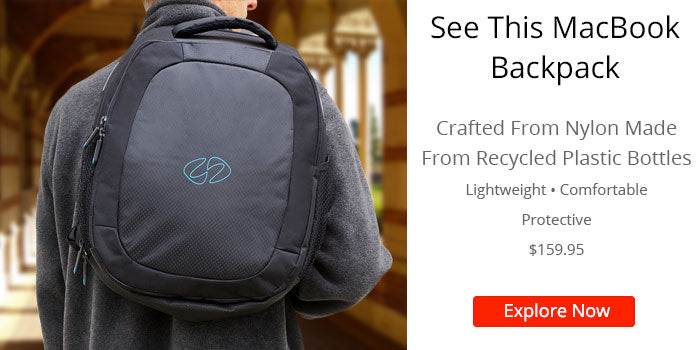What is the Most Comfortable Backpack?
When it comes to finding the most comfortable backpack, several factors come into play, ranging from smart, ergonomic design to quality fabrics and dense foam padding, adjustability, and good weight distribution and balance on the body.
Whether you're commuting with a tech backpack, meeting friends with your leather backpack, off to class with a laptop and tablet backpack, hiking with a wilderness model, or using a laptop backpack for everyday use, you want to be comfortable. But comfort is a subject thing. A pack that might be very comfortable for a person who is 6 feet tall might be terrible to wear for someone who is 5'2".
In this comprehensive guide, we'll explore what makes a backpack comfortable and highlight key features for you to consider when selecting the most comfortable option to meet your needs.
• Smart and Ergonomic Design
The most comfortable backpacks feature a smart, ergonomic design that takes into account the natural contours of the body and distributes weight evenly. Look for backpacks with contoured shoulder straps and a padded back panel that provide support and cushioning while minimizing pressure points on the shoulders and back.
Additionally, backpacks with a curved shape and adjustable sternum straps help improve stability and reduce strain on the upper body, ensuring a more comfortable carrying experience.
• Quality Fabrics and Dense Foam Padding
Quality fabrics and dense foam padding play a crucial role in enhancing the comfort of a backpack. Opt for backpacks made from durable and breathable materials such as rPET nylon, polyester, or premium leather, which provide excellent durability and moisture-wicking properties.
Adequate padding and cushioning are essential for maximizing comfort when wearing a backpack. Look for backpacks with generous padding in the shoulder straps, back panel, and hip belt, as well as cushioned lumbar support for added comfort and support. Additionally, backpacks with dense foam padding in key areas reduce fatigue and discomfort during prolonged wear.
• Finding a Perfect Fit
Adjustability is another key factor that contributes to the comfort of a backpack. Choose backpacks with adjustable shoulder straps, sternum straps, and hip belts that allow you to customize the fit according to your body size and preferences.
Adjustable straps help distribute weight evenly, prevent the backpack from shifting or bouncing, and optimize comfort for different users. Look for backpacks with easy-to-use adjustment mechanisms that allow for quick and hassle-free customization on the go.
Backpacks with good adjustability allow you to customize the level of cushioning according to your preferences, ensuring a comfortable fit for different body types and activities.
Which Backpacks Are the Most Comfortable?
The most comfortable backpacks are those with smart, ergonomic design, quality fabrics, dense foam padding, adjustability, good weight distribution, ventilation, and durability, offering support and comfort for extended wear.
Let's continue our list of what to look for so you can find the most comfortable backpack for you.
• Good Weight Distribution and Balance on the Body
Effective weight distribution and balance are essential for maintaining comfort while wearing a backpack. The most comfortable backpacks feature well-designed suspension systems that evenly distribute the weight of the load across the shoulders, back, and hips.
Look for backpacks with a supportive internal frame, load-lifting straps, and a padded hip belt that transfer weight from the shoulders to the hips, reducing strain on the upper body and providing better balance and stability.
• Ventilation and Airflow
Ventilation and airflow are important considerations for maintaining comfort, especially during warm weather or intense physical activity. Look for backpacks with breathable mesh panels and channels in the back panel that promote air circulation and prevent heat buildup. Ventilated backpacks help wick away moisture and keep you cool and comfortable, even during extended wear in hot and humid conditions.
• Size and Capacity
Choosing the right size and capacity is crucial for ensuring comfort when wearing a backpack. Select a backpack size that matches your torso length and accommodates your storage needs without being too bulky or oversized.
Consider the volume and organization of compartments and pockets to ensure easy access to belongings and efficient organization. Additionally, avoid over-packing your backpack, as carrying excessive weight can lead to discomfort and strain on the body.
• Durability and Longevity
Durability and longevity are key factors to consider when selecting a comfortable backpack. Choose backpacks made from high-quality materials and reinforced stitching that can withstand daily wear and tear, frequent use, and outdoor adventures. Look for backpacks with durable YKK zippers, robust hardware, and reinforced stress points that ensure long-lasting performance and reliability, providing comfort and support for years to come.
• Conclusion
The most comfortable backpacks feature a combination of smart ergonomics, quality fabrics and dense foam padding, adjustability, good weight distribution and balance on the body, ventilation and airflow, size and capacity, padding and cushioning, and durability and longevity.
When selecting a comfortable backpack, prioritize features that optimize comfort, support, and functionality while meeting your specific needs and preferences. By considering these key factors, you can choose the most comfortable backpack that enhances your carrying experience and provides maximum comfort during everyday use, commuting, traveling, hiking, or outdoor adventures.





